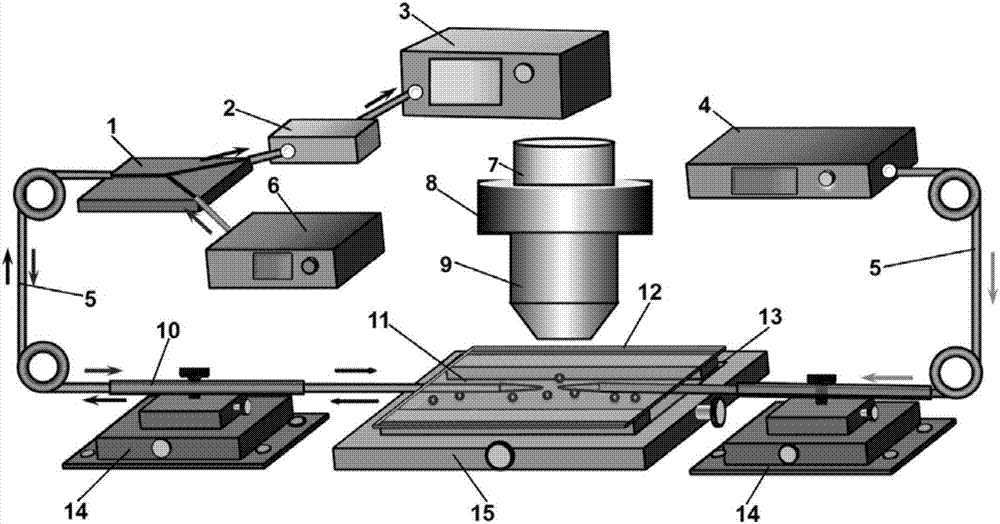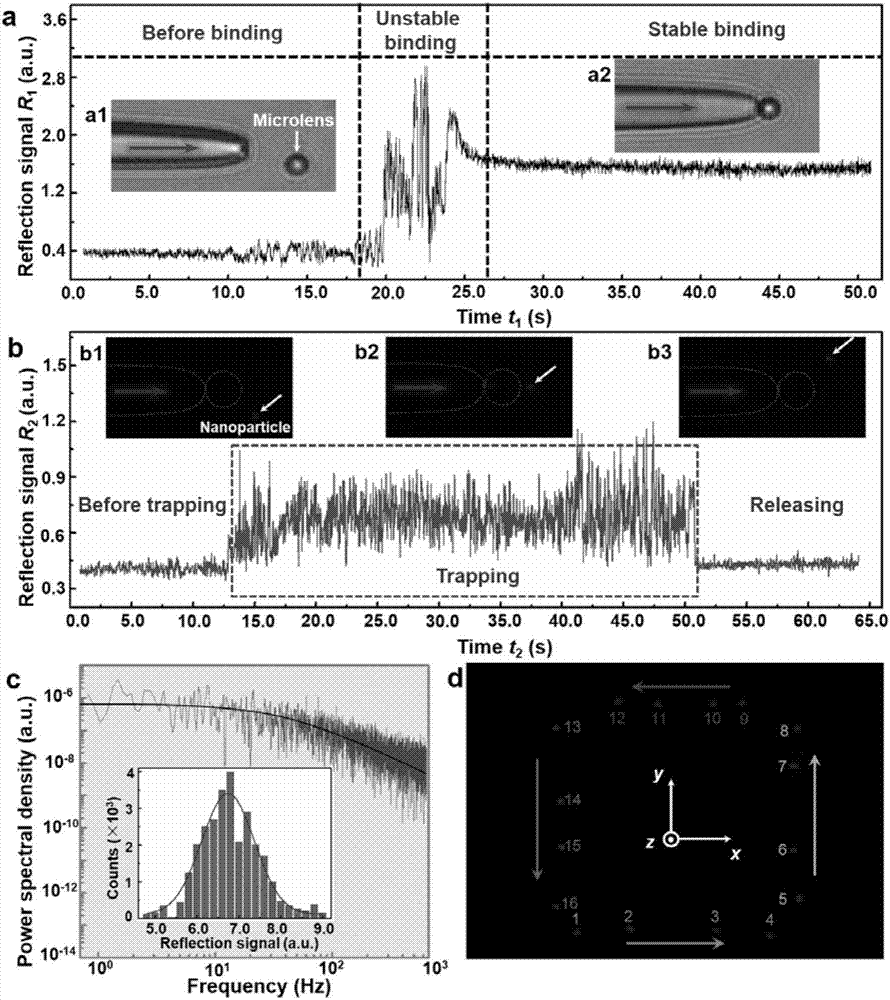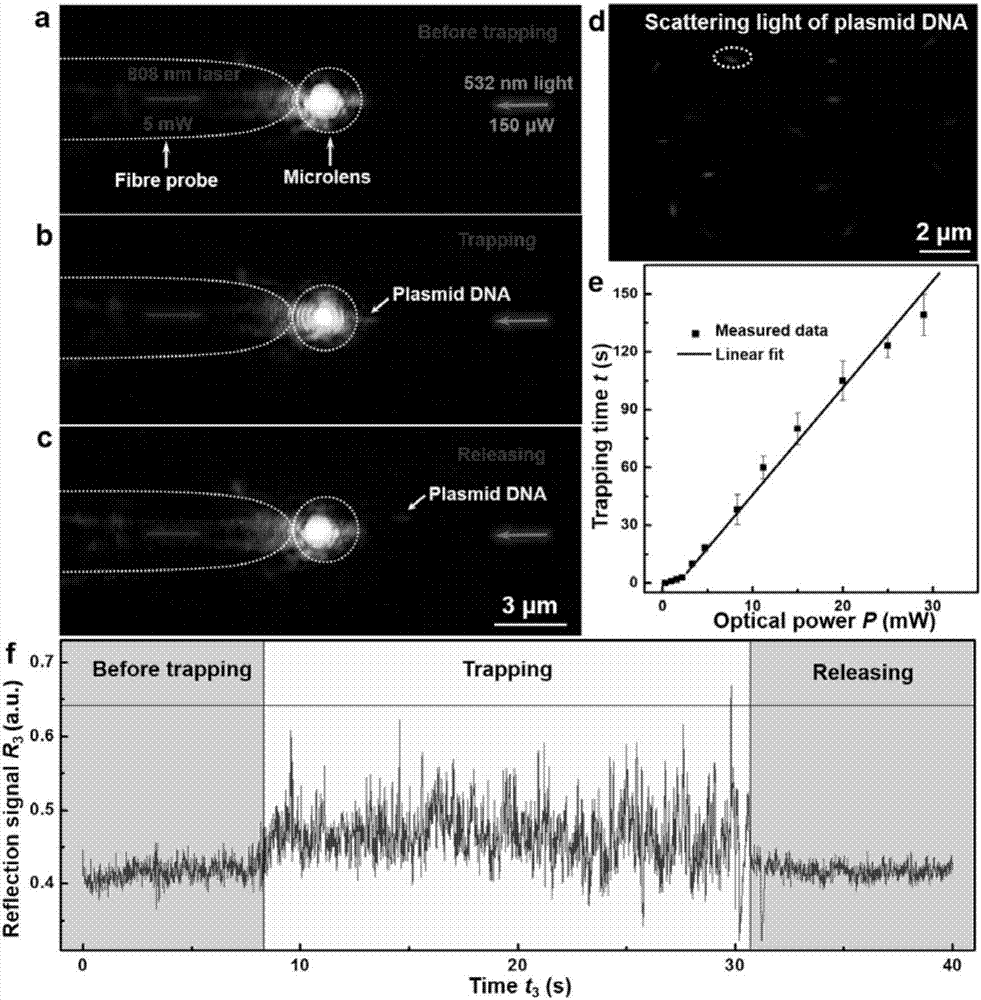Nanometer optical tweezers device and method for accurately controlling nanoparticles and biomolecules
A technology of nanoparticles and biomolecules, which is applied in the field of nano-optical tweezers, can solve the problems of low strength and precision, and achieve the effect of avoiding nanostructures and long nanomanufacturing processes
- Summary
- Abstract
- Description
- Claims
- Application Information
AI Technical Summary
Problems solved by technology
Method used
Image
Examples
preparation example Construction
[0067] Concrete preparation method is as follows:
[0068] Step 1.1: Strip the coating layer in the middle of the optical fiber with optical fiber strippers to obtain a bare optical fiber with a length of 1-2 cm and a diameter of 100-125 microns;
[0069] Step 1.2: Put the bare optical fiber prepared in step 1.1 into a glass capillary with an inner diameter of 0.9-1.0 mm and a length of 100-150 mm;
[0070] Step 1.3: Place the bare optical fiber horizontally on the outer flame above the alcohol lamp, and let it stand for 28-38 seconds under the condition of 500-550 degrees. After the optical fiber reaches the melting point, melt the molten part at a speed of 2 mm per second Thinning, when the diameter of the thinning part is reduced from 120-130 microns to 8-10 microns in the length of 1.6-1.8 mm, the drawing speed is increased to 10-15 mm per second to quickly break the optical fiber;
[0071] Step 1.4: Place the broken optical fiber under a microscope for observation. It ca...
Embodiment 1
[0095] Capture and Manipulation of Fluorescent Nanoparticles:
[0096] Process such as figure 2 As shown in (a), when the microlens is not adhered to the fiber tip, such as figure 2 As shown in (a1), the backscattered light signal measured at this time is relatively low; when the microlens is close to and finally adhered to the fiber tip, as shown in figure 2 As shown in (a2), the backscattering signal will first produce a certain jitter, because the adhesion is not stable enough at this time. After a period of time, the backscattering signal rises a step and tends to be stable, which proves that the microlens has been fixed on the fiber.
[0097] A laser with a wavelength of 808 nanometers is passed into the optical fiber, and a single fluorescent nanoparticle with a size of 85 nanometers will be captured by the photon nanojet and cause changes in the backscattered light signal, such as figure 2As shown in (b), the output power from the microlens has been measured to be...
Embodiment 2
[0103] Capture and manipulate DNA molecules:
[0104] Individual biomolecules are more difficult to capture and manipulate than nanoparticles due to their lower refractive index, smaller size, and irregular shape.
[0105] Before being captured, the plasmid DNA molecules were subjected to Brownian motion in the solution. When a laser with a power of 5 milliwatts was passed into the optical fiber, a single DNA molecule was successfully captured. After a period of time, the DNA molecules would undergo Brownian motion and The environment is shaken and released, and the representative picture of the whole process is as follows image 3 (a~c) shown.
[0106] In order to observe DNA molecules with an ordinary optical microscope, we pass a laser with a power of 150 microwatts and a wavelength of 532 nanometers into the optical fiber 2 to irradiate the DNA molecules from the side. After the DNA molecules are irradiated by the laser, they can be seen under the microscope. Green scatt...
PUM
| Property | Measurement | Unit |
|---|---|---|
| diameter | aaaaa | aaaaa |
| diameter | aaaaa | aaaaa |
| length | aaaaa | aaaaa |
Abstract
Description
Claims
Application Information
 Login to View More
Login to View More - R&D
- Intellectual Property
- Life Sciences
- Materials
- Tech Scout
- Unparalleled Data Quality
- Higher Quality Content
- 60% Fewer Hallucinations
Browse by: Latest US Patents, China's latest patents, Technical Efficacy Thesaurus, Application Domain, Technology Topic, Popular Technical Reports.
© 2025 PatSnap. All rights reserved.Legal|Privacy policy|Modern Slavery Act Transparency Statement|Sitemap|About US| Contact US: help@patsnap.com



